stream的用法总结大全
- 格式:doc
- 大小:13.78 KB
- 文档页数:4
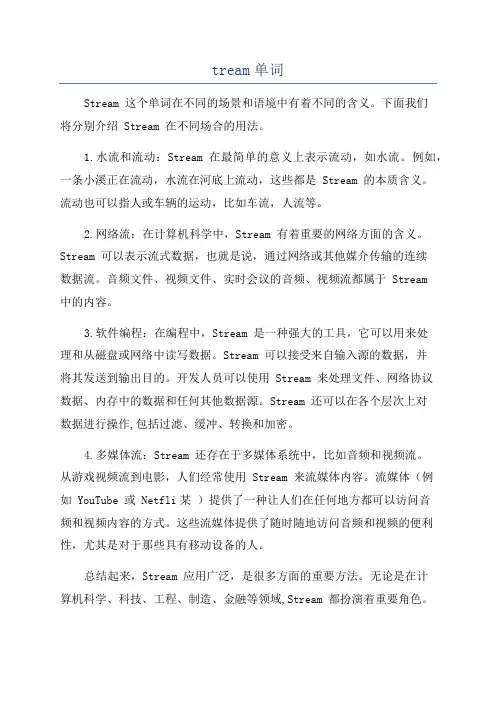
tream单词Stream 这个单词在不同的场景和语境中有着不同的含义。
下面我们将分别介绍 Stream 在不同场合的用法。
1.水流和流动:Stream 在最简单的意义上表示流动,如水流。
例如,一条小溪正在流动,水流在河底上流动,这些都是 Stream 的本质含义。
流动也可以指人或车辆的运动,比如车流,人流等。
2.网络流:在计算机科学中,Stream 有着重要的网络方面的含义。
Stream 可以表示流式数据,也就是说,通过网络或其他媒介传输的连续数据流。
音频文件、视频文件、实时会议的音频、视频流都属于 Stream中的内容。
3.软件编程:在编程中,Stream 是一种强大的工具,它可以用来处理和从磁盘或网络中读写数据。
Stream 可以接受来自输入源的数据,并将其发送到输出目的。
开发人员可以使用 Stream 来处理文件、网络协议数据、内存中的数据和任何其他数据源。
Stream 还可以在各个层次上对数据进行操作,包括过滤、缓冲、转换和加密。
4.多媒体流:Stream 还存在于多媒体系统中,比如音频和视频流。
从游戏视频流到电影,人们经常使用 Stream 来流媒体内容。
流媒体(例如 YouTube 或 Netfli某)提供了一种让人们在任何地方都可以访问音频和视频内容的方式。
这些流媒体提供了随时随地访问音频和视频的便利性,尤其是对于那些具有移动设备的人。
总结起来,Stream 应用广泛,是很多方面的重要方法。
无论是在计算机科学、科技、工程、制造、金融等领域,Stream 都扮演着重要角色。
越来越多的企业和机构也开始使用 Stream 技术来优化他们的业务流程或者产品。
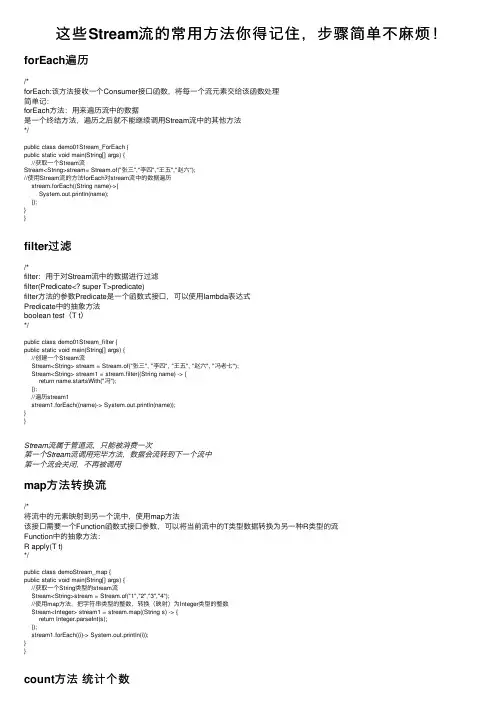
这些Stream流的常⽤⽅法你得记住,步骤简单不⿇烦!forEach遍历/*forEach:该⽅法接收⼀个Consumer接⼝函数,将每⼀个流元素交给该函数处理简单记:forEach⽅法:⽤来遍历流中的数据是⼀个终结⽅法,遍历之后就不能继续调⽤Stream流中的其他⽅法*/public class demo01Stream_ForEach {public static void main(String[] args) {//获取⼀个Stream流Stream<String>stream= Stream.of("张三","李四","王五","赵六");//使⽤Stream流的⽅法forEach对stream流中的数据遍历stream.forEach((String name)->{System.out.println(name);});}}filter过滤/*filter:⽤于对Stream流中的数据进⾏过滤filter(Predicate<? super T>predicate)filter⽅法的参数Predicate是⼀个函数式接⼝,可以使⽤lambda表达式Predicate中的抽象⽅法boolean test(T t)*/public class demo01Stream_filter {public static void main(String[] args) {//创建⼀个Stream流Stream<String> stream = Stream.of("张三", "李四", "王五", "赵六", "冯⽼七");Stream<String> stream1 = stream.filter((String name) -> {return name.startsWith("冯");});//遍历stream1stream1.forEach((name)-> System.out.println(name));}}Stream流属于管道流,只能被消费⼀次第⼀个Stream流调⽤完毕⽅法,数据会流转到下⼀个流中第⼀个流会关闭,不再被调⽤map⽅法转换流/*将流中的元素映射到另⼀个流中,使⽤map⽅法该接⼝需要⼀个Function函数式接⼝参数,可以将当前流中的T类型数据转换为另⼀种R类型的流Function中的抽象⽅法:R apply(T t)*/public class demoStream_map {public static void main(String[] args) {//获取⼀个String类型的stream流Stream<String>stream = Stream.of("1","2","3","4");//使⽤map⽅法,把字符串类型的整数,转换(映射)为Integer类型的整数Stream<Integer> stream1 = stream.map((String s) -> {return Integer.parseInt(s);});stream1.forEach((i)-> System.out.println(i));}}count⽅法统计个数/*count⽅法⽤于统计Stream流中的元素个数long count();count⽅法是⼀个终结⽅法,返回值是⼀个long类型的整数不能再调⽤Stream流其他⽅法*/public class demoStream_count {public static void main(String[] args) {ArrayList<Integer> list= new ArrayList<>();list.add(1);list.add(2);list.add(3);list.add(4);list.add(5);Stream<Integer> stream = list.stream();long count = stream.count();System.out.println(count);}}limit截取元素/*limit:⽤于截取流中的元素limit可以对流进⾏截取,只取⽤前n个limit(long maxSize);参数是⼀个long型,如果集合当前长度⼤于参数则进⾏截取,否则不进⾏操作limit是⼀个延迟⽅法,可以继续使⽤Stream流⽅法*/public class demoStream_limit {public static void main(String[] args) {String[] arr= {"xxx","wwq","wqew","wewqewqe"};Stream<String> stream = Stream.of(arr);Stream<String> stream1 = stream.limit(2);stream1.forEach((name)-> System.out.println(name));}}skip⽅法跳过元素/*skip⽅法:⽤于跳过元素skip(long n)如果流的当前长度⼤于n,则跳过前n个,否则将会得到⼀个长度为0的空流*/public class demoStream_skip {public static void main(String[] args) {String[] arr= {"xxx","wwq","wqew","wewqewqe"};Stream<String> stream = Stream.of(arr);Stream<String> stream1 = stream.skip(2);stream1.forEach((name)-> System.out.println(name));}}concat⽅法合并流/*concat:⽤于把流组合到⼀起如果有两个流,希望合并成为⼀个流,可以使⽤Stream接⼝的静态⽅法concat */public class demoStream_concat {public static void main(String[] args) {Stream<String> stream = Stream.of("张三", "李四", "王五", "赵六", "冯⽼七");String[] arr= {"QWQ", "ERE", "TYT", "UIU", "OIO"};Stream<String> stream1 = Stream.of(arr);//合并Stream<String> stream2 = Stream.concat(stream, stream1);stream2.forEach((name)-> System.out.print(name+" "));}}最后欢迎关注公众号:前程有光,领取⼀线⼤⼚Java⾯试题总结+各知识点学习思维导+⼀份300页pdf⽂档的Java核⼼知识点总结!。
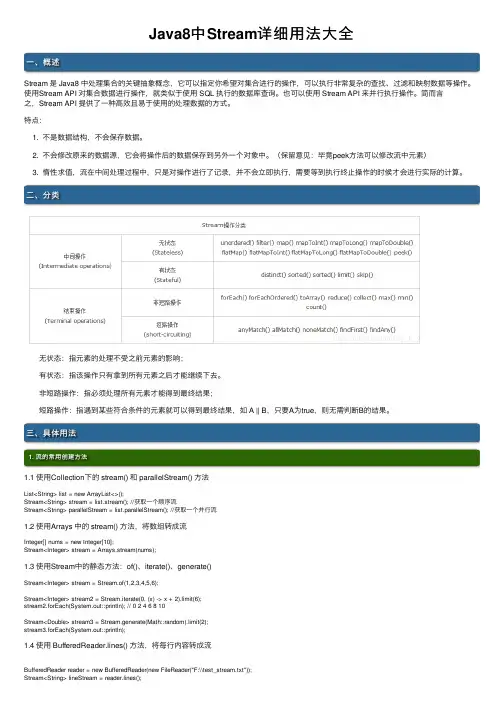
Java8中Stream详细⽤法⼤全⼀、概述Stream 是 Java8 中处理集合的关键抽象概念,它可以指定你希望对集合进⾏的操作,可以执⾏⾮常复杂的查找、过滤和映射数据等操作。
使⽤Stream API 对集合数据进⾏操作,就类似于使⽤ SQL 执⾏的数据库查询。
也可以使⽤ Stream API 来并⾏执⾏操作。
简⽽⾔之,Stream API 提供了⼀种⾼效且易于使⽤的处理数据的⽅式。
特点:1. 不是数据结构,不会保存数据。
2. 不会修改原来的数据源,它会将操作后的数据保存到另外⼀个对象中。
(保留意见:毕竟peek⽅法可以修改流中元素)3. 惰性求值,流在中间处理过程中,只是对操作进⾏了记录,并不会⽴即执⾏,需要等到执⾏终⽌操作的时候才会进⾏实际的计算。
⼆、分类 ⽆状态:指元素的处理不受之前元素的影响; 有状态:指该操作只有拿到所有元素之后才能继续下去。
⾮短路操作:指必须处理所有元素才能得到最终结果; 短路操作:指遇到某些符合条件的元素就可以得到最终结果,如 A || B,只要A为true,则⽆需判断B的结果。
三、具体⽤法1. 流的常⽤创建⽅法1.1 使⽤Collection下的 stream() 和 parallelStream() ⽅法List<String> list = new ArrayList<>();Stream<String> stream = list.stream(); //获取⼀个顺序流Stream<String> parallelStream = list.parallelStream(); //获取⼀个并⾏流1.2 使⽤Arrays 中的 stream() ⽅法,将数组转成流Integer[] nums = new Integer[10];Stream<Integer> stream = Arrays.stream(nums);1.3 使⽤Stream中的静态⽅法:of()、iterate()、generate()Stream<Integer> stream = Stream.of(1,2,3,4,5,6);Stream<Integer> stream2 = Stream.iterate(0, (x) -> x + 2).limit(6);stream2.forEach(System.out::println); // 0 2 4 6 8 10Stream<Double> stream3 = Stream.generate(Math::random).limit(2);stream3.forEach(System.out::println);1.4 使⽤ BufferedReader.lines() ⽅法,将每⾏内容转成流BufferedReader reader = new BufferedReader(new FileReader("F:\\test_stream.txt"));Stream<String> lineStream = reader.lines();lineStream.forEach(System.out::println);1.5 使⽤ Pattern.splitAsStream() ⽅法,将字符串分隔成流Pattern pattern = pile(",");Stream<String> stringStream = pattern.splitAsStream("a,b,c,d");stringStream.forEach(System.out::println);2. 流的中间操作2.1 筛选与切⽚ filter:过滤流中的某些元素 limit(n):获取n个元素 skip(n):跳过n元素,配合limit(n)可实现分页 distinct:通过流中元素的 hashCode() 和 equals() 去除重复元素Stream<Integer> stream = Stream.of(6, 4, 6, 7, 3, 9, 8, 10, 12, 14, 14);Stream<Integer> newStream = stream.filter(s -> s > 5) //6 6 7 9 8 10 12 14 14.distinct() //6 7 9 8 10 12 14.skip(2) //9 8 10 12 14.limit(2); //9 8newStream.forEach(System.out::println);2.2 映射 map:接收⼀个函数作为参数,该函数会被应⽤到每个元素上,并将其映射成⼀个新的元素。
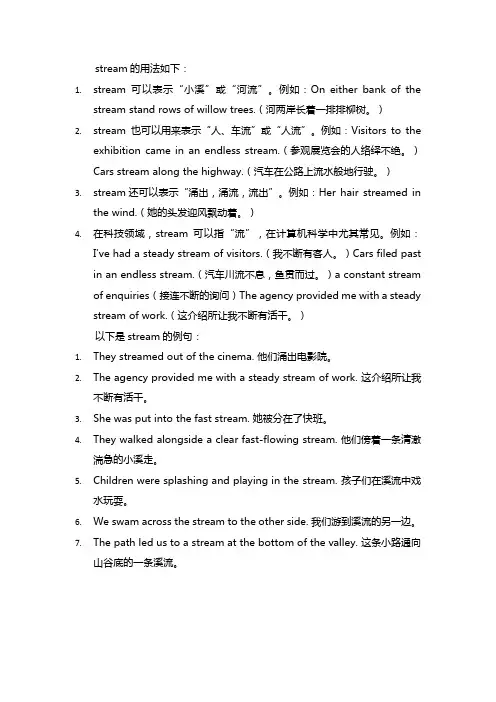
stream的用法如下:1.stream可以表示“小溪”或“河流”。
例如:On either bank of thestream stand rows of willow trees.(河两岸长着一排排柳树。
)2.stream也可以用来表示“人、车流”或“人流”。
例如:Visitors to theexhibition came in an endless stream.(参观展览会的人络绎不绝。
)Cars stream along the highway.(汽车在公路上流水般地行驶。
)3.stream还可以表示“涌出,涌流,流出”。
例如:Her hair streamed inthe wind.(她的头发迎风飘动着。
)4.在科技领域,stream可以指“流”,在计算机科学中尤其常见。
例如:I've had a steady stream of visitors.(我不断有客人。
)Cars filed past in an endless stream.(汽车川流不息,鱼贯而过。
)a constant stream of enquiries(接连不断的询问)The agency provided me with a steady stream of work.(这介绍所让我不断有活干。
)以下是stream的例句:1.They streamed out of the cinema. 他们涌出电影院。
2.The agency provided me with a steady stream of work. 这介绍所让我不断有活干。
3.She was put into the fast stream. 她被分在了快班。
4.They walked alongside a clear fast-flowing stream. 他们傍着一条清澈湍急的小溪走。
5.Children were splashing and playing in the stream. 孩子们在溪流中戏水玩耍。
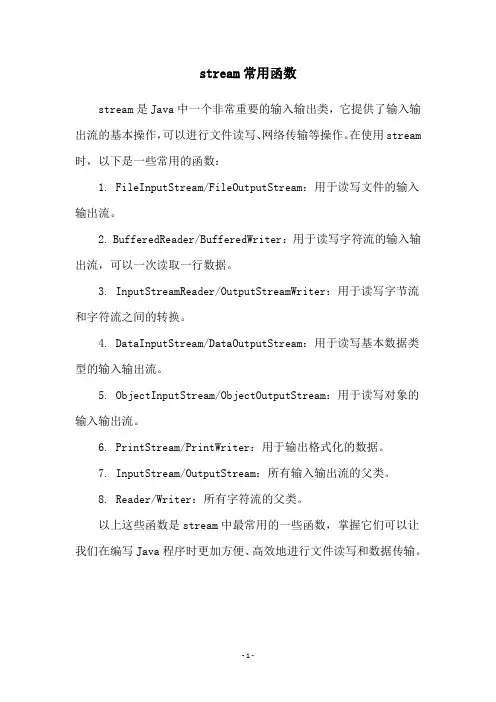
stream常用函数
stream是Java中一个非常重要的输入输出类,它提供了输入输出流的基本操作,可以进行文件读写、网络传输等操作。
在使用stream 时,以下是一些常用的函数:
1. FileInputStream/FileOutputStream:用于读写文件的输入输出流。
2. BufferedReader/BufferedWriter:用于读写字符流的输入输出流,可以一次读取一行数据。
3. InputStreamReader/OutputStreamWriter:用于读写字节流和字符流之间的转换。
4. DataInputStream/DataOutputStream:用于读写基本数据类型的输入输出流。
5. ObjectInputStream/ObjectOutputStream:用于读写对象的输入输出流。
6. PrintStream/PrintWriter:用于输出格式化的数据。
7. InputStream/OutputStream:所有输入输出流的父类。
8. Reader/Writer:所有字符流的父类。
以上这些函数是stream中最常用的一些函数,掌握它们可以让我们在编写Java程序时更加方便、高效地进行文件读写和数据传输。
- 1 -。
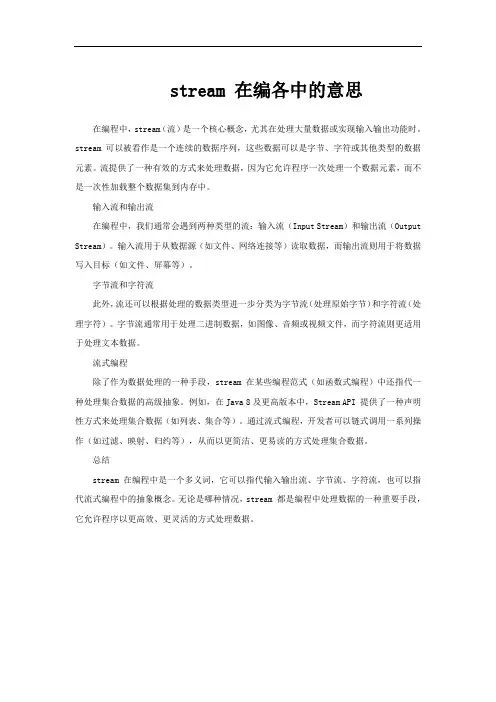
stream 在编各中的意思
在编程中,stream(流)是一个核心概念,尤其在处理大量数据或实现输入输出功能时。
stream 可以被看作是一个连续的数据序列,这些数据可以是字节、字符或其他类型的数据元素。
流提供了一种有效的方式来处理数据,因为它允许程序一次处理一个数据元素,而不是一次性加载整个数据集到内存中。
输入流和输出流
在编程中,我们通常会遇到两种类型的流:输入流(Input Stream)和输出流(Output Stream)。
输入流用于从数据源(如文件、网络连接等)读取数据,而输出流则用于将数据写入目标(如文件、屏幕等)。
字节流和字符流
此外,流还可以根据处理的数据类型进一步分类为字节流(处理原始字节)和字符流(处理字符)。
字节流通常用于处理二进制数据,如图像、音频或视频文件,而字符流则更适用于处理文本数据。
流式编程
除了作为数据处理的一种手段,stream 在某些编程范式(如函数式编程)中还指代一种处理集合数据的高级抽象。
例如,在Java 8及更高版本中,Stream API 提供了一种声明性方式来处理集合数据(如列表、集合等)。
通过流式编程,开发者可以链式调用一系列操作(如过滤、映射、归约等),从而以更简洁、更易读的方式处理集合数据。
总结
stream 在编程中是一个多义词,它可以指代输入输出流、字节流、字符流,也可以指代流式编程中的抽象概念。
无论是哪种情况,stream 都是编程中处理数据的一种重要手段,它允许程序以更高效、更灵活的方式处理数据。
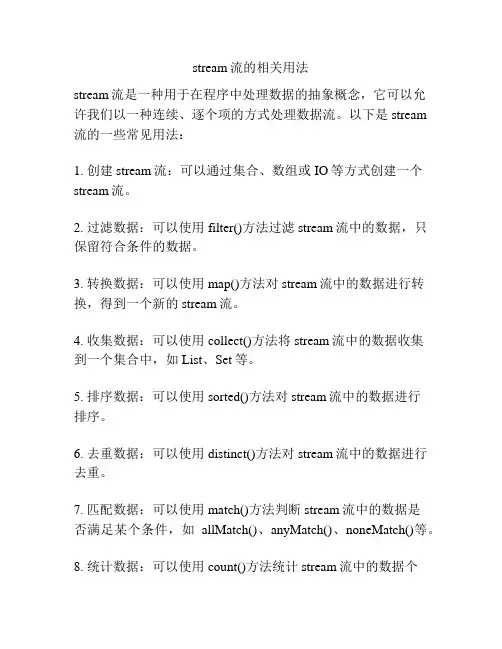
stream流的相关用法
stream流是一种用于在程序中处理数据的抽象概念,它可以允
许我们以一种连续、逐个项的方式处理数据流。
以下是stream 流的一些常见用法:
1. 创建stream流:可以通过集合、数组或IO等方式创建一个stream流。
2. 过滤数据:可以使用filter()方法过滤stream流中的数据,只保留符合条件的数据。
3. 转换数据:可以使用map()方法对stream流中的数据进行转换,得到一个新的stream流。
4. 收集数据:可以使用collect()方法将stream流中的数据收集
到一个集合中,如List、Set等。
5. 排序数据:可以使用sorted()方法对stream流中的数据进行
排序。
6. 去重数据:可以使用distinct()方法对stream流中的数据进行去重。
7. 匹配数据:可以使用match()方法判断stream流中的数据是
否满足某个条件,如allMatch()、anyMatch()、noneMatch()等。
8. 统计数据:可以使用count()方法统计stream流中的数据个
数。
9. 遍历数据:可以使用forEach()方法遍历stream流中的数据,并对每个数据执行特定的操作。
10. 并行处理:可以使用parallel()方法将stream流转换为并行流,以便并行处理数据,提高处理速度。
这些是stream流的一些常见用法,通过对stream流的灵活使用,可以简化代码并提高程序的效率。
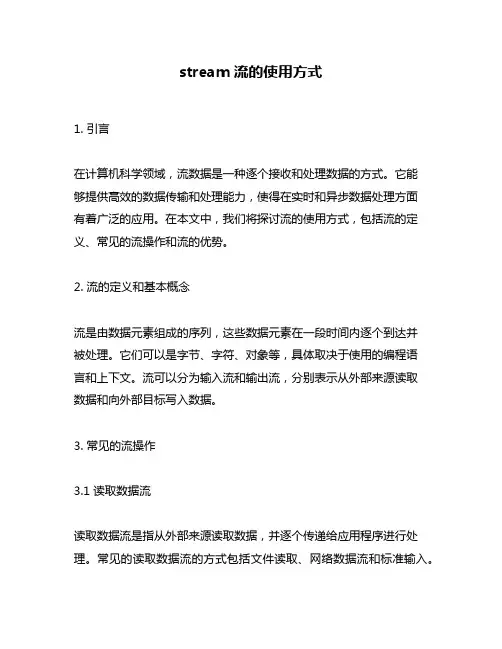
stream流的使用方式1. 引言在计算机科学领域,流数据是一种逐个接收和处理数据的方式。
它能够提供高效的数据传输和处理能力,使得在实时和异步数据处理方面有着广泛的应用。
在本文中,我们将探讨流的使用方式,包括流的定义、常见的流操作和流的优势。
2. 流的定义和基本概念流是由数据元素组成的序列,这些数据元素在一段时间内逐个到达并被处理。
它们可以是字节、字符、对象等,具体取决于使用的编程语言和上下文。
流可以分为输入流和输出流,分别表示从外部来源读取数据和向外部目标写入数据。
3. 常见的流操作3.1 读取数据流读取数据流是指从外部来源读取数据,并逐个传递给应用程序进行处理。
常见的读取数据流的方式包括文件读取、网络数据流和标准输入。
在Java中,可以使用BufferedReader类从文件中读取数据流:```import java.io.BufferedReader;import java.io.FileReader;import java.io.IOException;public class ReadFile {public static void main(String[] args) {try (BufferedReader reader = new BufferedReader(new FileReader("data.txt"))) {String line;while ((line = reader.readLine()) != null) {// 处理每一行数据System.out.println(line);}} catch (IOException e) {e.printStackTrace();}}}```3.2 写入数据流写入数据流是指将数据逐个写入外部目标,例如文件或网络连接。
常见的写入数据流的方式包括文件写入、网络数据流和标准输出。
在Python中,可以使用文件写入模式来写入数据流:```with open("data.txt", "w") as file:file.write("Hello, World!")```3.3 流的转换与过滤流的转换和过滤操作允许对数据流进行转换和处理。
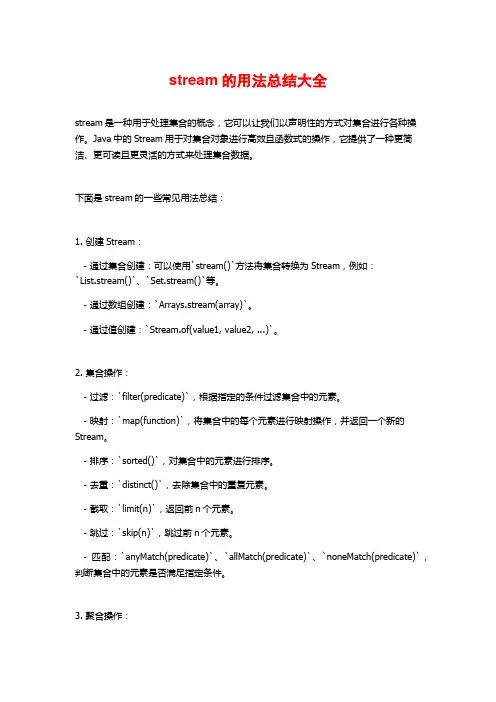
stream的用法总结大全stream是一种用于处理集合的概念,它可以让我们以声明性的方式对集合进行各种操作。
Java中的Stream用于对集合对象进行高效且函数式的操作,它提供了一种更简洁、更可读且更灵活的方式来处理集合数据。
下面是stream的一些常见用法总结:1. 创建Stream:- 通过集合创建:可以使用`stream()`方法将集合转换为Stream,例如:`List.stream()`、`Set.stream()`等。
- 通过数组创建:`Arrays.stream(array)`。
- 通过值创建:`Stream.of(value1, value2, ...)`。
2. 集合操作:- 过滤:`filter(predicate)`,根据指定的条件过滤集合中的元素。
- 映射:`map(function)`,将集合中的每个元素进行映射操作,并返回一个新的Stream。
- 排序:`sorted()`,对集合中的元素进行排序。
- 去重:`distinct()`,去除集合中的重复元素。
- 截取:`limit(n)`,返回前n个元素。
- 跳过:`skip(n)`,跳过前n个元素。
- 匹配:`anyMatch(predicate)`、`allMatch(predicate)`、`noneMatch(predicate)`,判断集合中的元素是否满足指定条件。
3. 聚合操作:- 统计个数:`count()`,返回集合中的元素个数。
- 求和、求平均、求最大值、求最小值:`sum()`、`average()`、`max()`、`min()`。
- 归约:`reduce(identity, accumulator)`,根据指定的累加器对集合中的元素进行归约操作。
4. 收集结果:- 转换为集合:`collect(Collectors.toList())`、`collect(Collectors.toSet())`等。
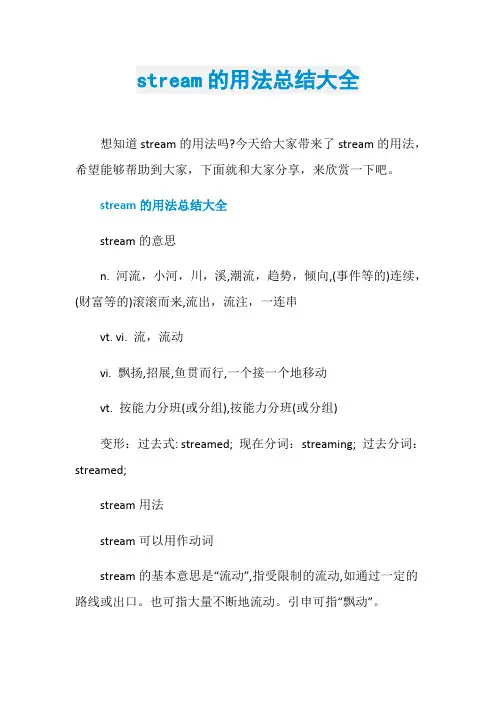
stream的用法总结大全想知道stream的用法吗?今天给大家带来了stream的用法,希望能够帮助到大家,下面就和大家分享,来欣赏一下吧。
stream的用法总结大全stream的意思n. 河流,小河,川,溪,潮流,趋势,倾向,(事件等的)连续,(财富等的)滚滚而来,流出,流注,一连串vt. vi. 流,流动vi. 飘扬,招展,鱼贯而行,一个接一个地移动vt. 按能力分班(或分组),按能力分班(或分组)变形:过去式: streamed; 现在分词:streaming; 过去分词:streamed;stream用法stream可以用作动词stream的基本意思是“流动”,指受限制的流动,如通过一定的路线或出口。
也可指大量不断地流动。
引申可指“飘动”。
stream既可用作及物动词,也可用作不及物动词。
用作及物动词时,可接名词或代词作宾语。
stream接介词with表示“被…覆盖”。
stream用作动词的用法例句Cars stream along the highway.汽车在公路上流水般地行驶。
They streamed out of the cinema.他们涌出电影院。
Her hair streamed(out) in the wind.她的头发迎风飘动着.stream用法例句1、The tidal stream or current gradually decreases in the shallows.浅滩上的潮水逐渐退去。
2、When someone has hayfever, the eyes and nose will stream and itch.花粉热临床表现为流泪、流涕,眼睛、鼻子发痒。
3、Businessmen stream into one of Tokyos商人不断涌进东京的一个主要火车站。
stream是什么意思及用法英音[stri:m] ;美音[stri:m] ;名词1.(小)河,(大)溪,河沟2.[~ (of sth/sb)](液体、人群、事物等的)流、流动或涌出3.(流动或移动的)水流、气流、趋势或趋向4.(especially BrE)(某些学校中同龄儿童按智力水平编成的)能力班或能力小组v.1.[~(from sth)|~(with sth)]液体或气体2.鱼贯而行,一个接一个地移动3.不及物动词:飘扬,招展(尤指在风中)4.(especially BrE)将(学童)按年龄和智力编班或分组词形变化形容词streamy时态streamed,streaming,streams英语解释to extend, wave or float outward, as if in the windrain heavilyexude profuselymove in large numbersflow freely and abundantlydominant course (suggestive of running water) of successive events or ideassomething that resembles a flowing stream in moving continuouslya steady flow (usually from natural causes)a natural body of running water flowing on or under the earththe act of flowing or streaming; continuous progressionstream的用法总结大全。
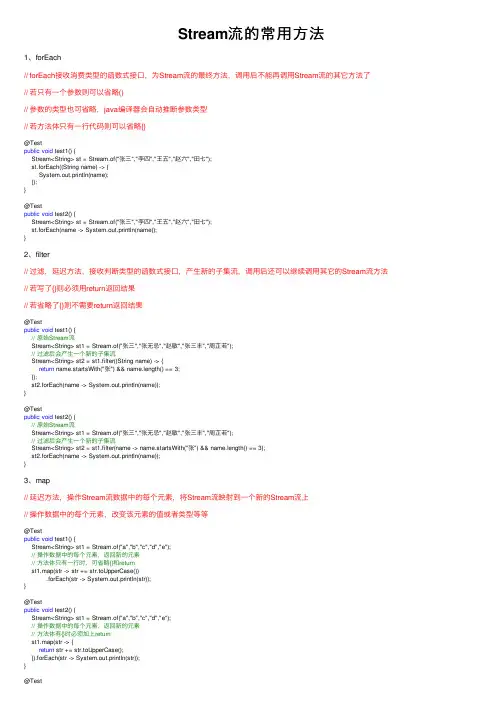
Stream流的常⽤⽅法1、forEach// forEach接收消费类型的函数式接⼝,为Stream流的最终⽅法,调⽤后不能再调⽤Stream流的其它⽅法了// 若只有⼀个参数则可以省略()// 参数的类型也可省略,java编译器会⾃动推断参数类型// 若⽅法体只有⼀⾏代码则可以省略{}@Testpublic void test1() {Stream<String> st = Stream.of("张三","李四","王五","赵六","⽥七");st.forEach((String name) -> {System.out.println(name);});}@Testpublic void test2() {Stream<String> st = Stream.of("张三","李四","王五","赵六","⽥七");st.forEach(name -> System.out.println(name));}2、filter// 过滤,延迟⽅法,接收判断类型的函数式接⼝,产⽣新的⼦集流,调⽤后还可以继续调⽤其它的Stream流⽅法// 若写了{}则必须⽤return返回结果// 若省略了{}则不需要return返回结果@Testpublic void test1() {// 原始Stream流Stream<String> st1 = Stream.of("张三","张⽆忌","赵敏","张三丰","周芷若");// 过滤后会产⽣⼀个新的⼦集流Stream<String> st2 = st1.filter((String name) -> {return name.startsWith("张") && name.length() == 3;});st2.forEach(name -> System.out.println(name));}@Testpublic void test2() {// 原始Stream流Stream<String> st1 = Stream.of("张三","张⽆忌","赵敏","张三丰","周芷若");// 过滤后会产⽣⼀个新的⼦集流Stream<String> st2 = st1.filter(name -> name.startsWith("张") && name.length() == 3);st2.forEach(name -> System.out.println(name));}3、map// 延迟⽅法,操作Stream流数据中的每个元素,将Stream流映射到⼀个新的Stream流上// 操作数据中的每个元素,改变该元素的值或者类型等等@Testpublic void test1() {Stream<String> st1 = Stream.of("a","b","c","d","e");// 操作数据中的每个元素,返回新的元素// ⽅法体只有⼀⾏时,可省略{}和returnst1.map(str -> str += str.toUpperCase()).forEach(str -> System.out.println(str));}@Testpublic void test2() {Stream<String> st1 = Stream.of("a","b","c","d","e");// 操作数据中的每个元素,返回新的元素// ⽅法体有{}时必须加上returnst1.map(str -> {return str += str.toUpperCase();}).forEach(str -> System.out.println(str));}@Testpublic void test3() {Stream<String> st1 = Stream.of("1","2","3","4","5");// 操作数据中的每个元素,将每个元素转为Integer类型Stream<Integer> st2 = st1.map(str -> Integer.parseInt(str));st2.forEach(num -> System.out.println(num.getClass()));}4、count// 最终⽅法,没有参数,没有⽅法体,属于Stream流的最终⽅法,⽤于统计Stream流中的数据长度,返回long类型@Testpublic void test4() {// count⽅法属于Stream流的最终⽅法,统计数据的长度,返回long类型Stream<String> st1 = Stream.of("1","2","3","4","5");long ct = st1.map(str -> Integer.parseInt(str)).filter(num -> num > 3).count();System.out.println(ct);}5、limit// 延迟⽅法,截取Stream流中的前⼏个元素返回新的Stream流,⼊参为long类型,没有⽅法体// 若⼊参的值⼤于Stream流中的数据的长度则返回由原数据组成的新Stream流@Testpublic void test1() {Stream<String> st1 = Stream.of("aa","bb","cc","dd","ee");st1.limit(3).forEach(str -> System.out.println(str));}6、skip// 延迟⽅法,⼊参为long类型,没有⽅法体,跳过前⼀个Stream流的前⼏个元素,得到由后⾯的元素组成的新Stream流@Testpublic void test2() {Stream<String> st1 = Stream.of("aa","bb","cc","dd","ee");st1.skip(2).forEach(str -> System.out.println(str));}// 若跳过的元素个数>=Stream流数据的长度则会得到⼀个元素个数为0的空流@Testpublic void test2() {Stream<String> st1 = Stream.of("aa","bb","cc","dd","ee");long ct = st1.skip(6).count();System.out.println(ct);}7、concat// Stream的静态⽅法,将多个Stream流的数据按⼊参顺序合并为⼀个新的Stream流@Testpublic void test3() {Stream<String> st1 = Stream.of("aa","bb","cc","dd","ee");Stream<String> st2 = Stream.of("AA","BB","CC","DD","EE");Stream<String> st3 = Stream.concat(st1,st2);st3.forEach(s -> System.out.println(s));}。
stream() 用法
`stream()`函数是Python 3中引入的一个内置函数,用于创建一个可迭代对象,通常用于处理字符串、列表、元组等序列数据。
`stream()`函数的主要作用是将一个可迭代对象转换为一个生成器,这样在处理大量数据时可以节省内存,提高程序运行效率。
以下是`stream()`函数的基本用法:
1. 直接应用于字符串、列表、元组等序列数据:
```python
# 示例:计算列表中每个元素的平方
squares = (x ** 2 for x in range(10))
for square in squares:
print(square)
```
2. 结合`map()`函数使用:
```python
# 示例:计算列表中每个元素的平方
squares = list(map(lambda x: x ** 2, range(10)))
print(squares)
```
3. 应用在生成器表达式中:
```python
# 示例:生成斐波那契数列
def fibonacci():
a, b = 0, 1
while True:
yield a
a, b = b, a + b
fib = fibonacci()
for i in range(10):
print(next(fib))
```
注意:在使用`stream()`函数时,应确保迭代器有无限个元素,否则可能会导致程序陷入无限循环。
在生成器表达式中,可以通过在函数内部使用`yield`关键字来控制生成器的执行流程。
Stream 用法流(Stream)是计算机科学中一个重要的概念,用于处理连续的数据流。
流可以是输入流(input stream)或输出流(output stream)。
流的使用广泛应用于各种编程语言和领域,如网络编程、文件处理、数据处理等。
本文将介绍流的基本概念、使用方法和常见应用场景。
流的基本概念流是一组有序的字节或字符序列,根据数据传输的方向可以分为输入流和输出流。
输入流用于从外部读取数据到程序,输出流用于将程序中的数据输出到外部。
流的特点有:•连续性:流是一连串的数据,数据按照一定的顺序从源头(输入流)流向目的地(输出流)。
•有限性:流的数据有开始和结束的标志,即流的尽头。
•顺序性:流中的数据按照先后顺序依次传输。
•单向性:流的数据只能单向流动,输入流用于读取数据,输出流用于写入数据。
流的使用方法在大多数编程语言中,流是通过类或对象来表示的。
典型的流类有输入流(InputStream)和输出流(OutputStream)。
不同的编程语言可能有不同的命名和实现方式,但基本概念和用法相似。
下面以Java语言为例,介绍流的使用方法。
输入流的使用使用输入流读取外部数据到程序中,主要涉及以下几个步骤:1.创建输入流对象:根据需要读取的数据来源(如文件、网络等),创建相应的输入流对象。
例如,可以使用FileInputStream读取文件中的数据。
2.打开输入流:打开输入流以准备接收数据。
例如,使用open()方法来打开文件输入流。
3.读取数据:通过输入流的读取方法(如read())读取数据。
读取方法将数据从输入流读取到程序中,通常以字节或字符的形式返回。
4.处理数据:对读取到的数据进行处理,如打印到控制台、写入文件等。
5.关闭输入流:读取完数据后,关闭输入流以释放资源。
使用close()方法关闭输入流。
下面是一个示例程序,演示了如何使用输入流读取文件中的数据:import java.io.FileInputStream;import java.io.IOException;public class InputStreamExample {public static void main(String[] args) {try (FileInputStream fis = new FileInputStream("input.txt")) {int data;while ((data = fis.read()) != -1) {System.out.print((char) data);}} catch (IOException e) {e.printStackTrace();}}}输出流的使用使用输出流将程序中的数据输出到外部,主要涉及以下几个步骤:1.创建输出流对象:根据数据输出的目的地(如文件、网络等),创建相应的输出流对象。
stream各种用法“哎呀,这 stream 用法还不简单嘛!”Stream 在编程中是一个非常重要的概念,它有多种用法呢。
首先,它可以用于对集合进行各种操作,比如筛选、映射、排序等等。
比如说,我们有一个整数列表,想要找出所有大于 50 的数,就可以通过 stream 来实现。
就像这样:List<Integer> numbers = Arrays.asList(10, 60, 30, 70, 40); List<Integer> greaterThan50 = numbers.stream().filter(n -> n > 50).toList(); 这样就得到了一个只包含大于 50 的数的新列表。
其次,stream 还可以进行数据的转换。
比如把一个字符串列表中的每个字符串都转换为大写,就可以这样做:List<String> names = Arrays.asList("alice", "bob", "charlie"); List<String> upperCaseNames = names.stream().map(name -> name.toUpperCase()).toList(); 这样就得到了所有名字都是大写的新列表。
另外,stream 也能实现对数据的排序。
假设有一个学生成绩的列表,我们可以按照成绩高低来排序。
比如:List<Student> students = // 这里是一些学生对象的列表; List<Student> sortedStudents = students.stream().sorted((s1, s2) -> s2.getScore() -s1.getScore()).toList(); 这样就得到了按成绩从高到低排序的学生列表。
Stream流的操作方法1. 什么是Stream流Stream(流)是Java 8引入的一个新的抽象层,它可以让开发者以一种声明性的方式处理数据集合。
Stream API提供了一组用于处理集合元素的高级操作,这些操作可以串行或并行执行。
Stream流有以下几个特点: - Stream不存储数据,它只是对数据进行操作。
- Stream不会改变源数据,它会生成一个新的Stream。
- Stream可以支持串行和并行操作。
2. 创建Stream流在使用Stream之前,我们首先需要创建一个Stream对象。
Java中有多种方式来创建Stream流,下面介绍几种常用的方式。
2.1 通过集合创建Stream我们可以通过集合类提供的stream()方法来创建一个包含集合元素的Stream流。
例如:List<String> list = Arrays.asList("apple", "banana", "orange");Stream<String> stream = list.stream();2.2 通过数组创建Stream我们可以使用Arrays类提供的stream()方法来创建一个包含数组元素的Stream 流。
例如:String[] array = {"apple", "banana", "orange"};Stream<String> stream = Arrays.stream(array);2.3 通过值直接创建Stream我们可以使用静态方法of()来直接将多个元素转换为一个包含这些元素的Stream 流。
例如:Stream<String> stream = Stream.of("apple", "banana", "orange");2.4 通过函数生成Stream我们可以使用Stream.generate()或Stream.iterate()方法来生成一个包含无限元素的Stream流。
stream()的用法
stream() 是 Java 8 引入的对集合进行流式操作的工具。
它的
主要作用是将集合转化为一个流,然后可以对流进行一系列的操作,
包括过滤、排序、映射、分组等等。
使用 stream() 的方式非常简单,可以直接在集合上面调用 stream() 方法即可。
例如,对一个 List
进行操作可以像这样写:List<String> list = new ArrayList<>(); Stream<String> stream = list.stream(); 然后,我们就可以使用stream 对象进行一系列的操作,比如:filter()、map()、reduce()
等等,来实现不同的需求。
stream 的优点在于它具有延迟执行的特性,也就是说,在没有调用终止操作之前,所有的操作都不会执行。
这样
避免了一些不必要的操作,提高了程序的效率。
stream的用法总结大全
想知道stream的用法吗?今天给大家带来了stream的用法,希望能够帮助到大家,下面就和大家分享,来欣赏一下吧。
stream的用法总结大全
stream的意思
n. 河流,小河,川,溪,潮流,趋势,倾向,(事件等的)连续,(财富等的)滚滚而来,流出,流注,一连串
vt. vi. 流,流动
vi. 飘扬,招展,鱼贯而行,一个接一个地移动
vt. 按能力分班(或分组),按能力分班(或分组)
变形:过去式: streamed; 现在分词:streaming; 过去分词:streamed;
stream用法
stream可以用作动词
stream的基本意思是“流动”,指受限制的流动,如通过一定的路线或出口。
也可指大量不断地流动。
引申可指“飘动”。
stream既可用作及物动词,也可用作不及物动词。
用作及物动词时,可接名词或代词作宾语。
stream接介词with表示“被…覆盖”。
stream用作动词的用法例句
Cars stream along the highway.汽车在公路上流水般地行驶。
They streamed out of the cinema.他们涌出电影院。
Her hair streamed(out) in the wind.她的头发迎风飘动着.
stream用法例句
1、The tidal stream or current gradually decreases in the shallows.
浅滩上的潮水逐渐退去。
2、When someone has hayfever, the eyes and nose will stream and itch.
花粉热临床表现为流泪、流涕,眼睛、鼻子发痒。
3、Businessmen stream into one of Tokyos
商人不断涌进东京的一个主要火车站。
stream是什么意思及用法。